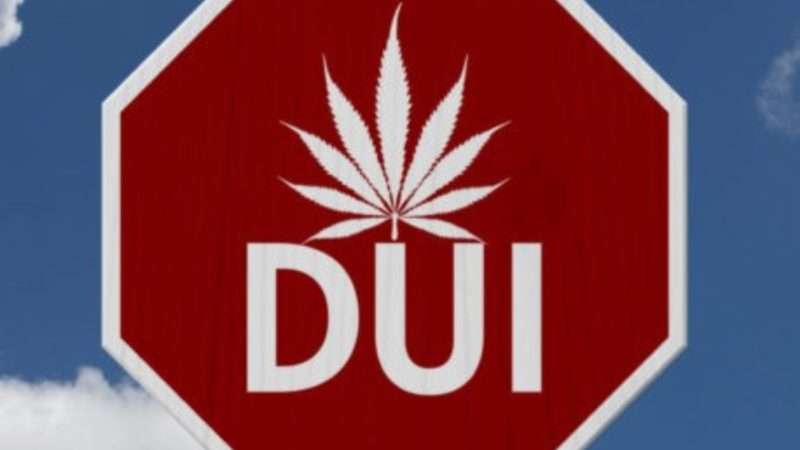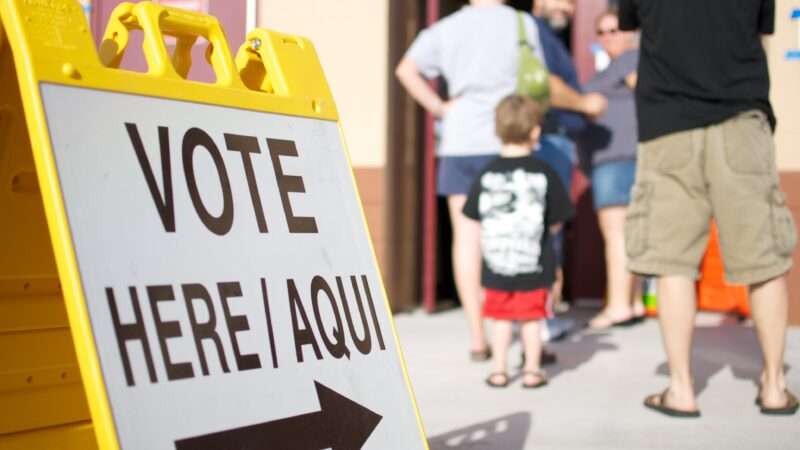A new study from the Insurance Institute for Highway Safety (IIHS) found that injury crash rates rose by about 7 percent in five states after they legalized recreational marijuana use. But there was no statistically significant increase in traffic fatality rates, and state-licensed recreational sales had no apparent impact on injury rates. Meanwhile, another IIHS study found that “drivers who used marijuana alone were no more likely to be involved in crashes than drivers who hadn’t used the drug.”
Given these mixed and counterintuitive results, the take offered by IIHS President David Harkey is misleading. “Our latest research makes it clear that legalizing marijuana for recreational use does increase overall crash rates,” Harkey said in a press release. “That’s obviously something policymakers and safety professionals will need to address as more states move to liberalize their laws—even if the way marijuana affects crash risk for individual drivers remains uncertain.”
The fear that marijuana legalization leads to more car crashes is based on the expectation that legalization increases use, resulting in more stoned drivers on the road. But if so, you would expect to see some impact from newly legal commercial distribution, and the IIHS study found no evidence of that. In fact, the researchers report a slight decrease in injury crash rates after state-licensed retailers opened, although that change was not statistically significant.
Furthermore, the effect of legalization on road safety depends crucially on “the way marijuana affects crash risk for individual drivers,” and the second IIHS study suggests that marijuana use does not increase crash risk. As the IIHS notes, that result is “consistent with a 2015 study by the National Highway Traffic Safety Administration [NHTSA],” which “found that a positive test for marijuana was not associated with increased risk of being involved in a police-reported crash.”
The IIHS researchers compared injury crash rates in five states that legalized marijuana (California, Colorado, Nevada, Oregon, and Washington) to trends in five Western states (Arizona, Idaho, Montana, New Mexico, Utah, and Wyoming) where recreational use was not legal during the study period. They found that legalization of recreational use was associated with “a statistically significant 6.6% increase in injury crash rates and a nonsignificant 2.3% increase in fatal crash rates.” But after retail sales began, injury crash rates fell slightly, reducing the increase following legalization to 5.9 percent. The overall increase in fatality rates was 3.8 percent, which was still statistically insignificant.
Those averages conceal considerable variation between states. “The effects of legal marijuana use and sales on injury crash rates ranged from a 7% decrease to an 18% increase,” the authors report. “The effects on fatal crash rates ranged from an 8% decrease to a 4% increase.” None of the changes in fatality rates was statistically significant.
Even assuming that legalization increases the number of stoned drivers, its net impact on crash rates is not as straightforward as people tend to assume. Laboratory studies indicate that marijuana has a much less dramatic impact on driving ability than alcohol does. Marijuana users are not only less impaired than drinkers but more aware of their impairment, taking precautions such as driving more slowly and maintaining more distance between vehicles.
Such compensatory behavior might help explain why the IIHS study found no significant impact on fatal crashes. “It is reasonable to expect that such behaviors will reduce the severity of crashes that result,” the authors note. “In that sense, past research suggests that fatal crash rates may be less affected by marijuana legalization than less severe crash rates. That is, the compensation exhibited by marijuana-impaired drivers, especially lower speeds, may not be sufficient to avoid a crash, but it may be enough to reduce the severity of that crash.”
Another consideration: To the extent that newly legal marijuana replaces alcohol, that substitution would tend to have a positive impact on road safety. The IIHS researchers note that “laws allowing the distribution of marijuana for medical purposes have been associated with an 8% to 11% reduction in traffic fatality rates—possibly because drivers are substituting marijuana for other, more impairing substances.” The implication of that framing is that marijuana might replace medications that have a bigger effect on driving ability. But in states with relatively loose rules for medical use, doctor-approved marijuana may also have replaced alcohol as a recreational intoxicant.
The second IIHS study underlines the point about the relative riskiness of stoned vs. drunk driving. The researchers looked at patients who were treated for crash-related injuries at three hospitals in Denver, Sacramento, and Portland, Oregon. In addition to asking the patients about drug and alcohol use prior to their accidents, they tested blood samples. Comparing the patients to a control group, they found “no increased crash risk associated with [marijuana], except when [it was] combined with alcohol.”
As the IIHS notes, “studies of whether marijuana itself makes drivers more likely to crash have been inconsistent.” Two meta-analyses published in 2012 found that cannabis consumption roughly doubles the risk of a crash. A 2018 meta-analysis of 26 studies estimated that marijuana use increases the risk of a crash by 18 percent to 32 percent. By comparison, a 2016 study sponsored by NHTSA found that a blood alcohol concentration (BAC) of 0.08 percent, the current DUI threshold in almost every state, was associated with a fourfold increase in crash risk, while a BAC of 0.10 percent, the old cutoff, nearly sextupled the risk.
While marijuana’s contribution to car crashes remains unclear, the results of the IIHS hospital study are consistent with what NHTSA found in 2015, when it looked at accidents in Virginia Beach, Virginia. In that study, which the agency described as the “largest and most comprehensive” of its kind, marijuana use was not associated with an elevated crash risk once other variables were taken into account.
The NHTSA researchers matched each of 3,000 drivers who were involved in crashes with two drivers who were not but who were on the road in the same location on the same day of the week at the same time and traveling in the same direction. The initial analysis found that drivers who tested positive for THC were 25 percent more likely to be involved in crashes. But that difference disappeared once the researchers took into account age, gender, race/ethnicity, and alcohol use.
Those results suggest that recent cannabis consumption could be an indicator of other variables that independently affect crash risk. “If the THC-positive drivers were predominantly young males,” NHTSA noted, “their apparent crash risk may have been related to age and gender rather than use of THC.”
Michael White, an Australian psychologist who keeps track of research on marijuana and driving, thinks that observation may explain the results of other studies that did not adjust for confounding variables. “What they report as a marijuana effect might well be a young man effect,” he says. Young men are especially likely to be cannabis consumers and especially prone to crashes even when they are perfectly sober. Furthermore, the sort of young men who think nothing of getting behind the wheel right after smoking pot are probably more reckless than the ones who decide that’s not such a good idea.
There is some evidence that marijuana and alcohol together impair driving ability more than either alone, although not all researchers agree on that point. If marijuana legalization makes the joint use of both intoxicants more common, that might help account for the increase in crash injuries that the IIHS found.
In the hospital study, the IIHS notes, “13 percent of the crash-involved drivers tested positive for marijuana only, compared with 16 percent of the control set.” But “the reverse was true for the combined use of marijuana and alcohol,” with “5 percent of the crash-involved drivers and [less] than 1 percent of the control drivers testing positive.” The IIHS says “those combined-use numbers could help explain why crash rates have increased.” It suggests that “legalization may be encouraging more people to drink and use marijuana together.”
If so, that still would not explain why easy availability of marijuana from state-licensed outlets had no apparent effect on crash injuries. Do people go wild once they can no longer be busted for pot possession, recklessly driving after drinking and toking, then calm down after they can actually walk into shops and legally buy marijuana? Maybe new cannabis consumers learn the dangers of such behavior from experience, but how many new cannabis consumers are there when the only sources of marijuana are home cultivation and the black market?
The IIHS researchers do not really grapple with that puzzle. But they do warn that their results should not be overinterpreted.
“Even if legalization leads to a higher prevalence of driving after marijuana use, the increased crash rates may be due to other, unobserved factors,” they say. “Marijuana users may be riskier drivers even when not impaired, and the legalization of marijuana may encourage more travel by these risky drivers. For example, marijuana users in counties that do not allow retail sales may drive to counties where such sales are permitted. Some states have used the legalization of marijuana as part of their tourism promotions, bringing in more potentially risky drivers. Thus, the results of this study do not necessarily imply that marijuana use before driving increases the risk of a crash.”

from Latest – Reason.com https://ift.tt/3d7S9g2
via IFTTT





